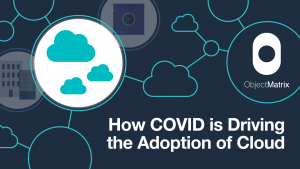Object Matrix’s Nicholas Pearce on How COVID-19 Is Driving the Adoption of Cloud
Story Highlights
Cloud adoption has been in motion for some time now, but the pandemic has made remote access to content much more of a necessity. With cloudification increasing, organiZations need to consider how they will manage their infrastructure over the long-term, before jumping into new storage solutions.
 In this blog, Nicholas Pearce, Co-founder and Chief Revenue Officer, Object Matrix answers a few questions about the company’s reaction to the Covid-19 pandemic, the effect on the wider industry, as well as what’s on the horizon.
In this blog, Nicholas Pearce, Co-founder and Chief Revenue Officer, Object Matrix answers a few questions about the company’s reaction to the Covid-19 pandemic, the effect on the wider industry, as well as what’s on the horizon.
How have you dealt with the past year?
As with every other company we had to quickly adapt to remote working. With many of the team often traveling to various trade shows and customer meetings, we are used to working from anywhere much of the time so that was not too big a challenge. Also, as we already use our own browser-based collaboration tool, MatrixStore Vision, for our files, we know we can access that from anywhere.
The biggest challenge about remote working for the team was the lack of interaction and engagement with each other, and customers. People buy from people so not being able to travel has made that more difficult. Thankfully it didn’t affect sales, and if anything, led to a lot of new customers coming on board looking to improve their storage and ensure remote access to all their media files no matter where the team is located.
We have addressed the interaction challenges as best we could through the use of video and webinars with partners and customers. Those have been well received for the large part. I have also added my own personality to a number of fun videos, including a series of “Good News Friday” videos to lift people’s spirits amongst the doom and gloom.
How do you think the media industry responded to the pandemic?
The media industry was already transitioning towards more cloud-based tools which has certainly eased the situation. Those media companies with traditional workflows and tape storage have struggled the most, as COVID highlighted the need for a drastic, but very fast overhaul of entire workflows. Migrating entire archives from tape storage during a pandemic is not without its challenges.
Production has also become very challenging due to stay-at-home rules, a lack of live events, and social distancing requirements. That said, the media industry has adapted well, and fast. We have seen a rising importance of the archive, with many providers turning to archived material to keep audiences engaged while production was paused.
What do you think the next 12 months hold in terms of workflows?
The pandemic has largely accelerated trends that were already happening; therefore, it is unlikely that we will return to pre-pandemic workflows entirely. I think we will see many more hybrid workflows, delivering the best of both worlds and maximising efficiencies. Consumers have been engaging extremely well with archived content across all genres. I believe that the archive will become a more integral part of content strategies going forward, but that will only be possible if content housed within the archive is fully discoverable.
Organisations need to look at implementing hybrid or multi-cloud solutions which help create a hierarchy of content value. Some content can easily move to deep archive, whereas other assets need to be readily available. Identifying the most effective format for different types of content will help to avoid unnecessary egress fees and make storage more efficient. It’s also important to ensure that the metadata associated with key footage is stored in an open format, so teams can keep control of their assets and avoid being tied into platforms or applications.
How can the industry benefit from cloud storage going forward?
The ubiquitous term “cloud” doesn’t do justice to the diverse solutions which can be combined to suit different organisation’s needs. While initial low expenditure for public cloud usage is tempting, the data access and billing can quickly become unpredictable if all your eggs are in the same basket. Media organisations frequently need to access archive footage and a restrictive approach to data portability can cause real challenges for production teams. Many public cloud solutions are simply not designed for creative media workflows.
It’s clear that Covid is going to have a lasting impact on the type of content which is created. The industry has seen the potential of maximising archive footage to generate new content, particularly in the sports world where the disruption has been extensive. But in order to make the most of an organisation’s assets there needs to be a balance between accessibility and cost. Covid may be driving us towards widespread cloud adoption, but media organisations need to make sure they are keeping both hands on the wheel.
